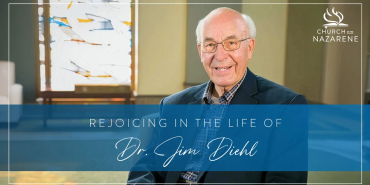Please Close the Back Door!

In my September 2005 "Compass" column for Holiness Today, I wrote about the Cali, Colombia, House of Prayer Church of the Nazarene. I jubilantly testified to worshiping with nearly 6,000 happy Colombians in March 2005. Nine months later, Louie Bustle, director of World Mission, was honored to speak there to more than 12,000 people in a combined stadium service! More than 500 friends embraced faith in Jesus. ¡Gloria a Dios!
Craig Rench, pastor of First Church of the Nazarene in Anaheim, California, studied local church cell leader multiplication and made some alarming observations. "Retention rates among American evangelical churches range from 2 percent to 16 percent. Retention rate is the percentage of new believers who are still in the church one year after conversion. Congregations that embrace cell leader multiplication often see retention rates jump to over 50 percent." The Cali church has an excellent retention rate of 40 percent!
Why is this important?
Jesus said: "Ye have not chosen me, but I have chosen you, and ordained you, that ye should go and bring forth fruit, and that your fruit should remain" (John 15:16, KJV; emphasis added). "Therefore go and make disciples of all nations, baptizing them in the name of the Father and of the Son and of the Holy Spirit, and teaching them to obey everything I have commanded you" (Matthew 28:19-20, emphasis added). Our Lord has commissioned us to make disciples who remain.
Rench notes that 90 percent of new believers in the U.S. will fall away from the church within 12 months. We celebrate the hundreds of thousands who embrace faith and join the Church of the Nazarene around the world! However, the back door is open!
This past quadrennium we lost three of every four who joined our church family, not to mention new converts who were never incorporated into a local congregation.This is a critical challenge as we move toward our denominational centennial celebration. Together we will close the back door!
Author and pastor Michael Henderson reminds us: "The Lord said, 'I will build my church. You make disciples.' We however, are intent on building the church, and who is making disciples?" Craig Rench has outlined a strategy for Anaheim First Church that is built on similar principles to those God is blessing in Cali.
This movement is based on personal holiness, fervent prayer, evangelistic passion, and proactive follow-up with new believers, incorporating them into long-term discipling relationships:
The Master's Plan
- WIN: A friend embraces faith in Christ. Immediately the new believer joins a Life Group that meets weekly for prayer, encouragement, and Bible study. The Life Group is open to new and nonbelievers.
- CONSOLIDATE: A 90-day discipleship journey.
- DISCIPLE: A nine-month period of discipleship, which includes participants discovering God's plan for them, their families, their worlds, and their ministries.
- SEND: During the final training level, new leaders are commissioned to launch their own Life Groups. These new leaders will study Christian maturity and Holy Spirit fruitfulness.
A Life Group leader will eventually launch a Lead Group of up to 12 people who have completed one year of discipleship, have begun their own Life Groups, and have demonstrated that they are faithful and fruitful leaders. Lead Groups meet weekly for prayer, accountability, training, Bible study, and evangelism strategizing.
Our Lord invested His life into 12 disciples, and Paul also mobilized leaders who reproduced leaders. Paul wrote to Timothy: "Pass on what you heard from me to reliable leaders who are competent to teach others" (2 Timothy 2:2, TM).We can close the back door as we make disciples who remain by:
- Being incorporated into cell groups
- Being discipled in the Word
- Launching their own cell groups
- Deploying their disciples
This must become our priority, to the glory of God!
Jerry D. Porter is a general superintendent in the Church of the Nazarene*
Holiness Today, September/October 2007
Please note: This article was originally published in 2007. All facts, figures, and titles were accurate to the best of our knowledge at that time but may have since changed.




